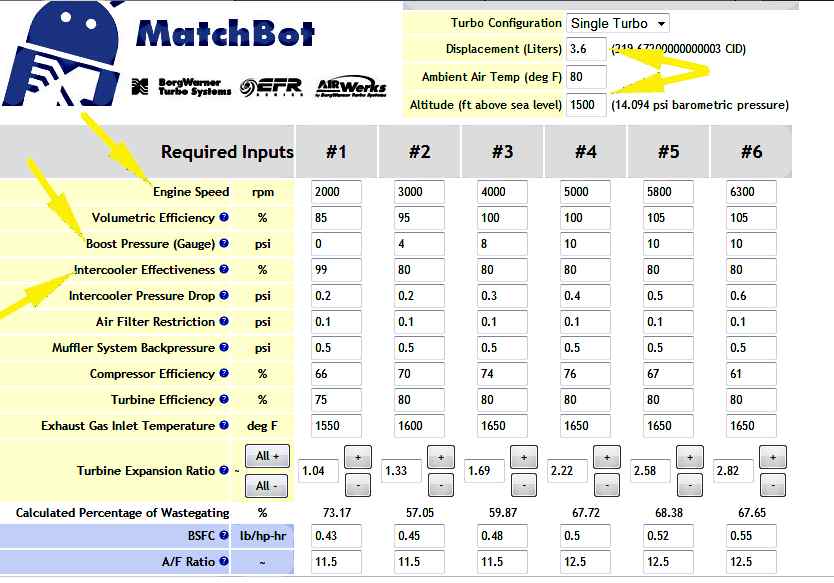
...........Return To Mine & Other Bonneville Car Construction Pages
=================================================================
--- GM Atlas 3500/3700 (3.5/3.7 liter) Turbo Compressor Maps ---
=================================================================
On this page you will find some turbo compressor maps for turbos that might be a good fit for the Atlas 5 cylinder motor (3500/3700).
The 3500/3700 are 5 cylinder versions of the 4200 6 cylinder that was used in the Trailblazer. The engines in the Atlas line are basically the same engine, just different number of cylinders. The 4 and 5 cylinder engines have balance shafts where as the 6 doesn't as it doesn't need them.
Some of these might be a possible turbo to use and some not. Please if you consider any of these you need to do "your" homework and don't make a decision based entirely on what you see below.
To create these maps I used Borg Warner's MatchBot web-base program that you can find ( HERE ).

Above is the input screen from MatchBot and I left all of the data as you see above but changed the rpm/boost points to represent different levels of boost. I also set the RPM points and the Intercooler Efficiency but left the rest at the MatchBot defaults. You will see the boost levels on each map and the corresponding peak HP for those levels. Since the 5 cylinder came in first a 3.5 liter and then after that was discontinued a 3.7 liter I inputted 3.6 liters above since it was close to the 3.5 and 3.7.
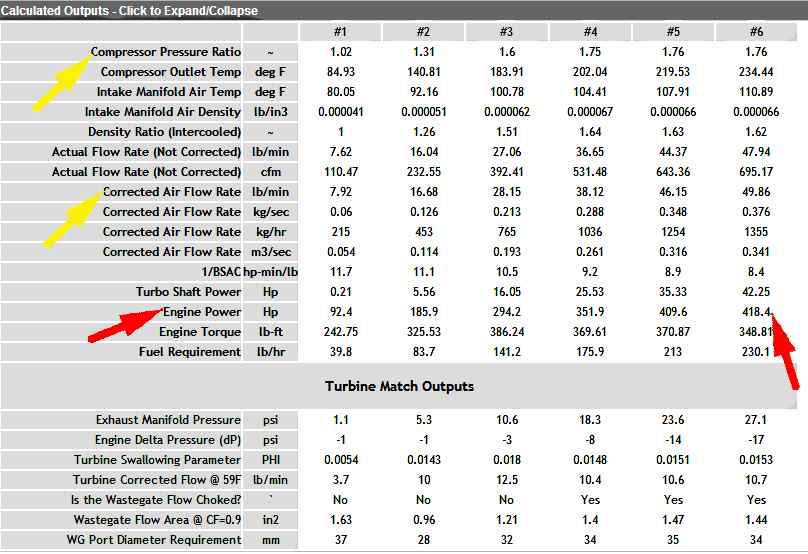
To plot the points on the compressor maps I took the Pressure Ratios and Corrected Air Flow Rates (see yellow arrows) and plotted them on the maps. Also note that the projected HP outputs are also given, red arrows. In this case 418 HP at the 10 lbs. of boost at 6300rpm.
A Pressure Ratio of 1 is atmospheric pressure at sea level and 2 would be twice that or about 15 lbs. of boost. Forget the boost just figure that at 15 lbs. you have twice atmospheric pressure so you are getting in twice the air in the motor so have the potential of creating twice the HP (minus other factors). This would be boost at the manifold and not at the compressor output and is the reason you see "corrected air flow rate". A PR of 3 would be 3 times the air vs. sea level. To illustrate some of this let's take a look at a map and compare how two different engines, one a 2 liter and the other a 4.2 liter would work with the same turbo.
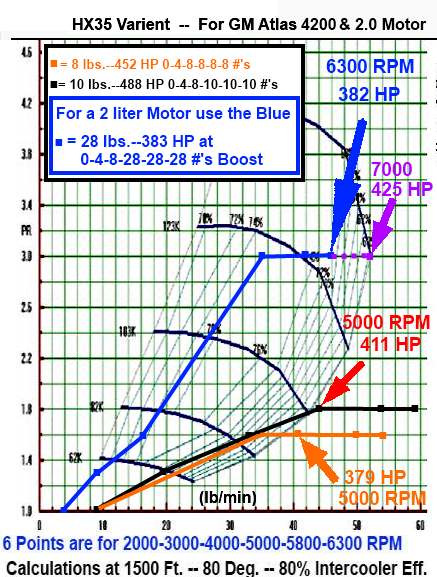
The map above is for a HX-35 that a friend was interested in using on his 4200 (4.2 liter). The bottom two plots (black/orange) are for the 4200. The red/orange arrows show the points where the turbo just can't keep up with the air the 4200 needs which is at the 5000 rpm point for both levels of boost (8 lbs./10 lbs.). Past 5000 up to our 6300 rpm redline we move way off the map for our last two points. Even up to 5000 rpm the turbo is working in an inefficient area of the map where the air would be hot and causing potential problems.
I then left MatchBot's inputs alone and changed the engine size down to a 2 liter motor. With it I was able to get the boost up to ~ 29 lbs or a pressure ratio of 3 where the map extends the furtherest to the right and the compressor can develop up to 50 lb/min of air. There at 6300 rpm it made 382 HP but raising the rpm further to 7000 rpm and staying at 29-30 lbs. of boost now it made enough air to make 425 HP with the 2 liter motor.
So now without increasing the boost we raised the HP by more than 40 HP by raising the RPM to take advantage of the air the compressor is capable of producing. If we would of raised the boost we would not of been able to move as far to the right side of the map but would run into the speed line where the compressor wheel would over-speed and maybe fail. This is a case where more boost probably would not of made more HP as we were already at a point on the map of maximum air production by the compressor. This is an important point to understand.
You might say just run the 4200 at a higher boost, I hear this all the time. The problem is that at 29-30 lbs. of boost on the 4200 it will consume 3 times the amount of air that it would not under boost or 75 lbs. at 5000, 91 lbs. at 5800 and 98 lbs. of air at 6300. Looking at the map above the turbo's compressor is only capable of about 52 lbs. of air max so raising the boost is not going to work. We could raise the boost on the 2.0 liter since it consumes less air for each 2 revolutions of the motor. =================================================================
NOTE: Think Air Consumption in lbs/min used by the engine and Air Production air in lbs/min produced by the compressor side of the turbo. Not Boost to match a turbo to your situation. Air consumed by the engine is based mainly on displacement, rpm, and the air pressure above atmospheric pressure.
=================================================================
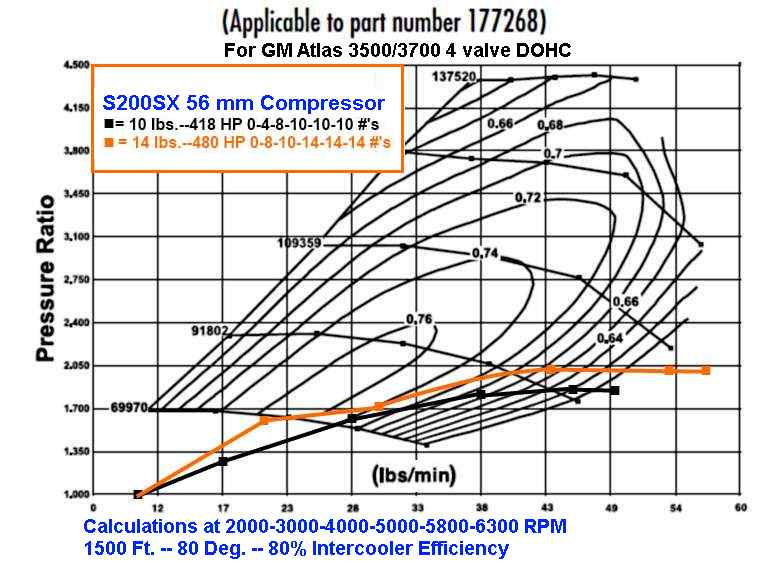
Let's start with some turbos that "don't fit" the 3500/3700 very well. The Borg Warner S200SX (one of a number of S200SX's) just doesn't make enough air for the 3.5/3.7 as is shown above with its compressor map. Notice at the low levels of boost (10# and 14#) the compressor doesn't make enough air at the higher rpm limits. This would be a good turbo for a smaller motor working up in the 2.4 to 2.7 pressure ratio area.
Would it work at all on a 3500-3700? Yes up into the 5000 rpm range probably but over in the inefficient side of the map. Since it isn't the best choice why use it? The same with the next turbo.
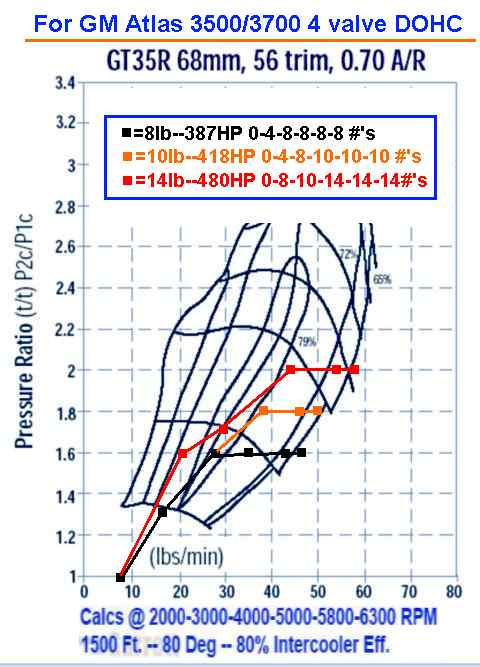
The GT35R above also starts to run out of air at the higher rpm levels, above 5000, where the engine's need for air increases. Notice that is true at the different boost levels. At higher boost levels the turbo can produce more air as shown by the way the map slopes off to the right. The problem is that as the boost goes up the engine needs more air as the boost fills the cylinders with more air each time they fill. Still if you were welling to only run the engine to about 5500 you would be making more HP at the higher boost level as we are over in the 50+ lbs/min area of the map there and it is the lbs/min of air mixed with the fuel than makes the HP not the boost.
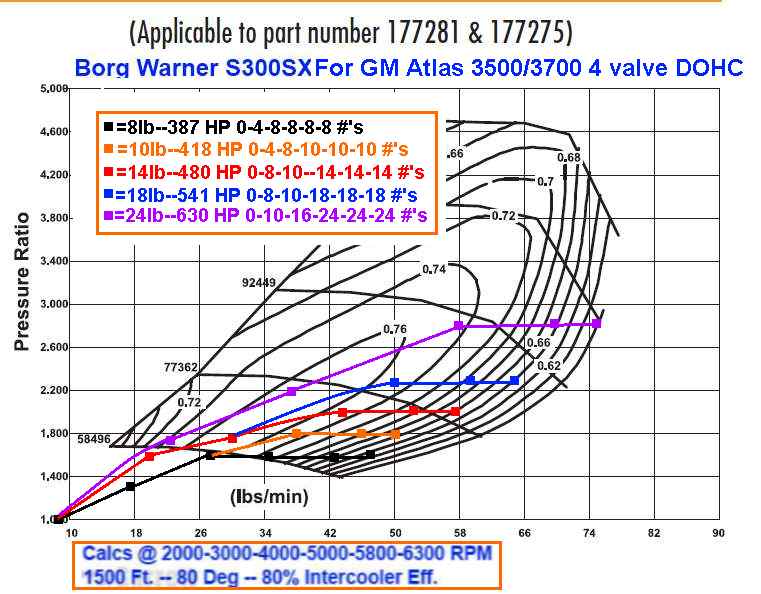
The Borg Warner S300SX above looks better but still not great. Notice two things. One is that at higher rpm's it is getting down into the mid 60% efficiency range. The other is that at lower boost levels it is just barely on the map which would probably make it pretty lazy down there. This is a good turbo like some of the others above, just not a great fit for this motor.
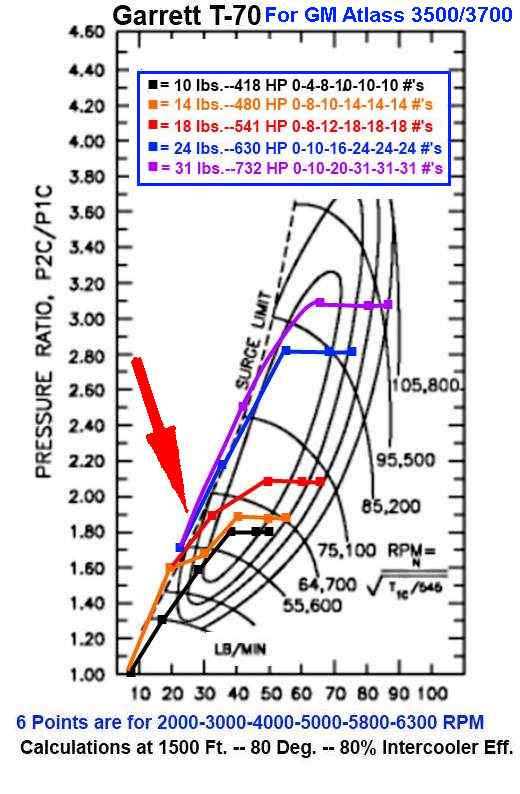
The Turbonetic's T-70 above can supply the air all the way up to about 700+ HP but might have a problem with surge as it is close to supplying too much air down at the lower rpm/boost levels, see area of red arrow, where it is operating in the area just to the left of the surge line. Now it might not be a problem in real life but the next Turbonetic's turbos seem to take care of the supply side without the possibility of surge under boost so why not consider them over the T-70.
A turbo goes into surge when it can produce more air than the engine can consume and the air not being used reverses back to the turbo and tries to stall the compressor wheel. This is not good and can quickly cause damage to the compressor. Also a BOV (blow off valve) will not take care of this situation. It only prevents surge when you let off the throttle and the engine goes into vacuum and opens the valve and lets the air headed back towards the compressor escape without damage to the compressor.
With all of that in mind lets look for a turbo that will work well with the 3500/3700 engines. Let's start with ones that would be the more street friendly and be the most responsive (spool quicker) and move one by one to turbos that are more street/strip oriented.
==================================================================
NOTE: Below you will see me reference Turbonetic's Hurricane Series turbos in a couple cases. This is a series of turbos that have smaller compressor housings with larger wheels in them and they have done this to package them better for people who are having problems room wise in their engine compartments. . For instance the next turbo can be ordered as a T66 or a Hurricane model where the compressor wheel is in a 60 series housing vs. the T series housing. Putting the larger wheel in the smaller housing is going to lower the flow some. The maps below are with the compressor wheel in the larger housing and if you see "Hurricane" you will know that the flow will be somewhat less than the map shows. Turbonetics doesn't publish the maps for the Hurricane series but will tell you to use the maps for the compressors with the same wheel in the larger housing and you will be close.
Also almost all of the Hurricane Series turbos have a ported shroud that moves the surge line to the left that can help in running a larger compressor on a smaller engine. The Hurricane series will sacrifice some potential HP at the upper limit but will be more responsive on the street. So make a choice and call one of their techs before making a final decision.
==================================================================
Next up are some Turbonetics turbos that look like good matches for the 3500/3700.
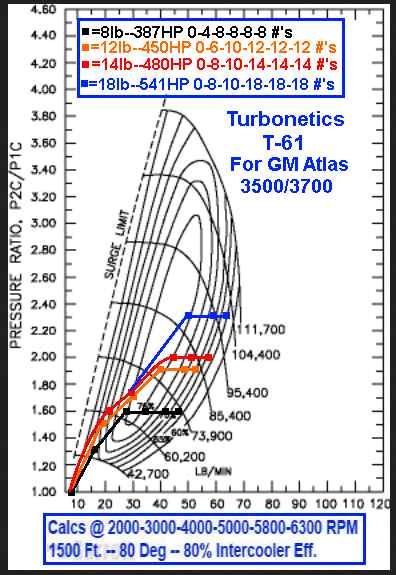
The smallest of the group is the T-61 above that is operating mainly on the right side of the map. This turbo with small A/R turbines would be real responsive. One problem is I have not had a good time finding this turbo for sale although it might be one of the compressor choices ( HERE ) as the HP-61.
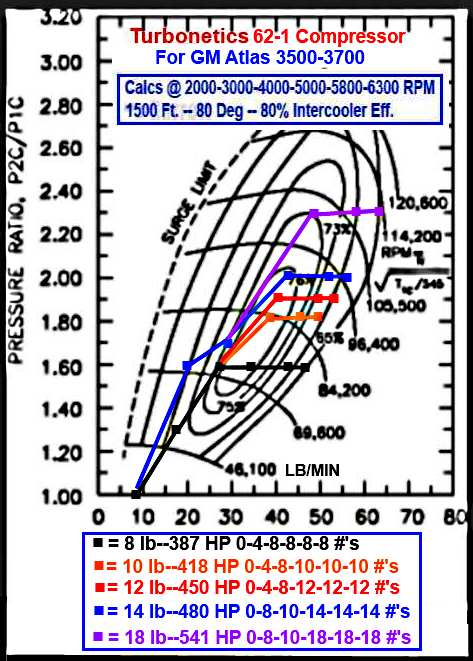
The 62-1 above should also spool very quickly using a T3 turbine with a .63 A/R and the larger T4 compressor side and I'd consider it if your goal is in the 387 HP to 450 HP. Both Summit and Jegs carry this turbo and others also. If Ruth and I buy a Colorado/Canyon with the 3700 this might be near or at the top of the list to look at for purely a street turbo. Notice that it works well with the 10-14 lb. boost levels where it moves up into the map where it leans further to the right. Still even with 8 lbs. it looks very good except at 6300 where it is moving towards the edge of the map. I think I'd put 10 lb. springs in the waste gate. As I mentioned above before buying talk to a tech at Turbonetics about your goals before buying any of these turbos.
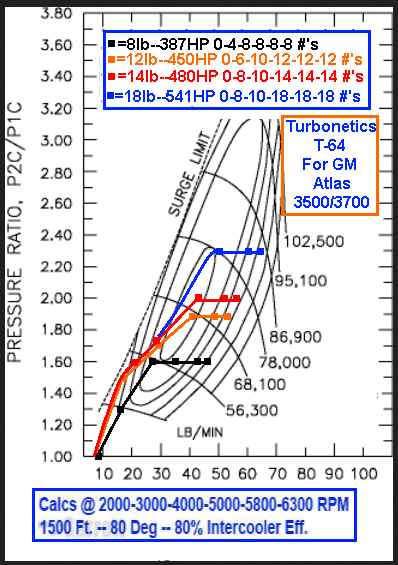
As you can see from the 64's map above we are now moving into the more efficient areas of the map with the plots and this turbo should be fine till over 500 HP. Notice though that the first point of the 8 lb. boost line is at the bottom edge of the map vs. further into the map like on the turbo before this. From that I wouldn't expect it to be quite as responsive but still that point is only 4 lbs. of boost and by 8 we are well into the map. I can't find this turbo on the market (Internet) so think it might be discontinued. Other than that it looks to be a very nice fit for a 3500/3700.
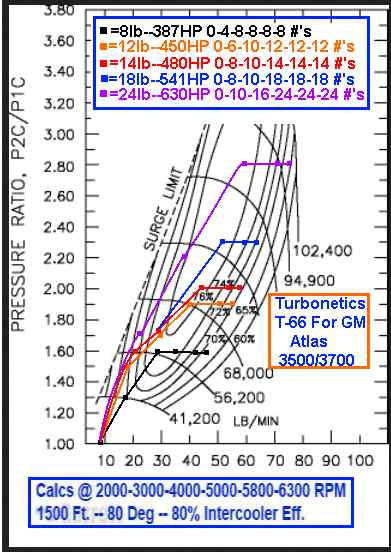
The T-66 above is moving into the area that if you want to get into the 600 HP level that it is capable of producing on a 3500/3700 that your motor is going to probably at least need better pistons at a minimum. Still this turbo looks pretty responsive down at the 8 lbs. of boost so might be one to consider if you are going to do mods to your motor down the road and want a turbo that can keep up with them. Start with one of their smaller turbines and go larger later on the turbine side or if you are staying street get one of the Hurricane Series with the HP-66 Compressor. A little less flow than the T-66 but still should be a very nice turbo in the 500 HP range.
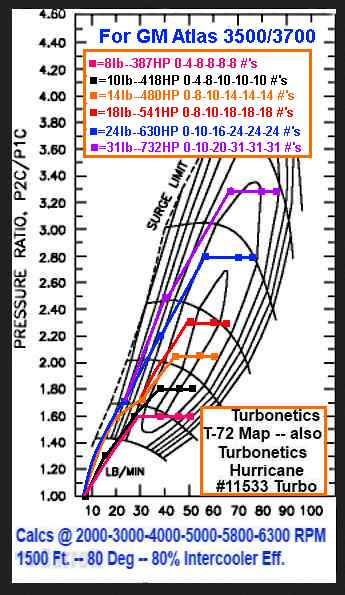
Since the T-70 (further up this page) was getting close I decided to try their T-72 (slightly larger) and feel this is the best match I've found to date for a 3500/3700 in the way of a street/strip turbo with more emphasis on 'serious street'. Notice how at about any boost level the compressor is working in the most efficient area of the map. You can find the T72 for sale for a little under $1000 and also as a Hurricane Series (P/N 11533) turbo from Turbonetics with the HP-72 wheel. It is going to flow a little less than the T-72 but should be more responsive and is under $800 at places like Summit. One interesting thing about the Hurricane turbo is that the ported shroud moves the surge line over to the left so it becomes more surge resistant while under lower boost levels than say the T-70 further up the page.
The Hurricane uses the T-72 compressor along with a 68mm turbine with a very spool friendly .81 A/R. This should be a very responsive turbo on a 3500/3700 and also has capabilities of over 600 HP. The negative about this Hurricane combination is that the 72 mm wheel is in a 60 series housing and the largest wheel they put in that housing which is going to make it flow somewhat less than a normal T-72 turbo and it won't be quite as efficient. On the street not a bad deal but if you are looking for the higher HP levels then I wouldn't go with the Hurricane but the regular T-72 or a turbo further down the page. Of course before the flow would become a problem you would need to have a non-stock motor with good rods and crank and other mods. The Hurrican 11533 is available from Jegs and Summit Racing and others for $800 or less in the plain journal version or around $1200 in the ceramic ball bearing model that I don't think the majority of us need. If you go onto the next page with turbos for the 4200 you will see that the Hurricane works very well on that motor also.
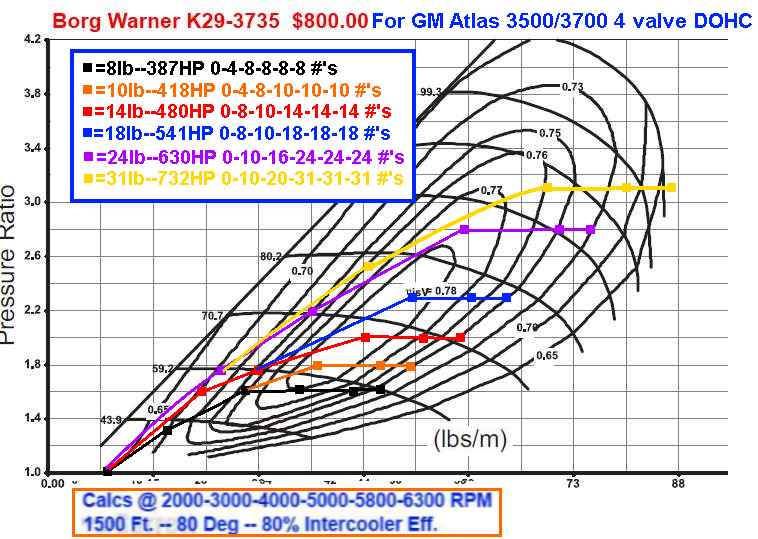
The Borg Warner K29 above also looks like a good match for the 3500/3700 except for a couple issues. One is that it has a 1.0 A/R so would be slower to spool vs. some of the other turbo above. It is a twin scroll where you can help the spool by feeding 1/2 the cylinders (every other firing one) into one side and the other 1/2 into the other side. Of course with a 5 cylinder how do you do that so we are still stuck. The other problem is that the turbine inlet flange and outlet flanges are not like any other turbos so you would have to make those. Not a big deal but be aware of that.
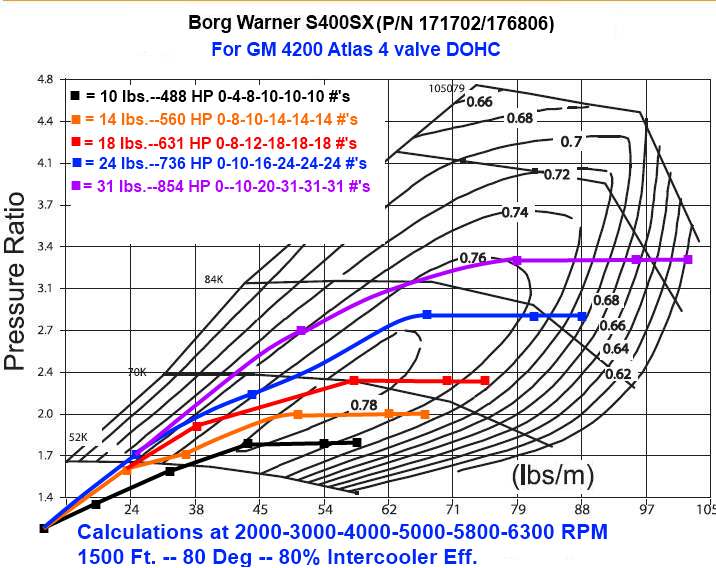
If you are looking for very high HP numbers with the 3500/3700 and will give up lower rpm HP the above turbo at under $750 would be worth a look. It would be slow to spool with the 1.32 A/R on the turbine but a smaller turbine could be used on it and not give up too much on the top end. I would only consider the turbo above for Bonneville where high HP is the goal and spool is not.
==================================================================
..........Return To Mine & Other Bonneville Car Construction Pages